Kia Telluride 2023 Smart Cruise Control (SCC)
-
The 2023 Kia Telluride’s Smart Cruise Control (SCC) stands out as a shining example of how to make driving easier and safer in today’s world, where car technology is always changing. The advanced feature in this car goes beyond the usual idea of cruise control and into the world of intelligent adaptability. At the heart of this new idea is a system that not only keeps the Telluride going at a set speed, but can also sense the road ahead and change its speed in real-time to keep a safe distance from the car in front of it. As the SUV drives on freeways and city streets, SCC works hard as a co-pilot, reducing the need to constantly speed up and slow down. This makes driving more comfortable and safer.
With this article, we’ll look into the 2023 Kia Telluride’s Smart Cruise Control in detail, showing you how it works, how it can be used in different situations, and how it changes the driving experience, showing Kia’s dedication to making driving smarter and easier. - 2023 Kia Telluride Specs, Price, Features and Mileage (Brochure)
Smart Cruise Control (SCC)
Cruise control Kia Telluride 2023:
Basic function
Smart Cruise Control is designed to help detect the vehicle ahead and help maintain the desired speed and minimum distance between the vehicle ahead.
Overtake acceleration assist function
If the driver attempts to overtake, the vehicle will accelerate to assist in overtaking.
Based on driving style (if equipped)
When Smart Cruise Control is operating, the vehicle applies to the driver’s driving style.
Detecting sensor
Front view camera
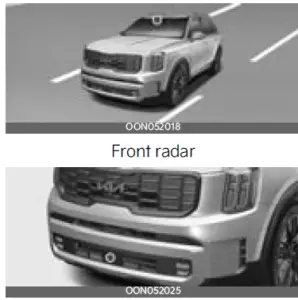
Front corner radar (if equipped)
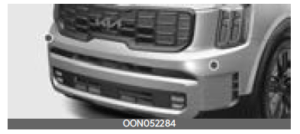
The front view camera and front radar, and front corner radars (if equipped) are used as a detecting sensor to detect front vehicles.
Refer to the picture above for the detailed location of the detecting sensor.
CAUTION
Always keep the front view camera and front radar in good condition to maintain optimal performance of Smart Cruise Control.
Smart Cruise Control settings
Cruise control Kia Telluride 2023

A: Driver Assistance
- Smart Cruise Control
With the vehicle on, touch Settings → Vehicle → Driver Assistance → Driving Convenience → Smart Cruise Control on the infotainment system to set the instance, acceleration and the reaction speed.
Based on driving style (if equipped)

A: Driving convenience
- Smart Cruise Control
- Based on driving style
With the vehicle on, if Settings → Vehicle → Driver assistance → Driving convenience → Smart Cruise Control → Based on Driving Style is selected from the infotainment system screen, Smart Cruise Control will operate based on the driver’s driving style, such as vehicle distance, acceleration, reaction speed.
The driver’s driving style can be adjusted each driving style manually.
NOTICE
- If equipped with Based on Driving Style, Based on driving mode and Based on driving style can be selected from the infotainment system screen by selecting Settings → Vehicle → Driver assistance → Driving convenience → Smart Cruise Control.
- If Based on driving mode is selected, Smart Cruise Control will operate based on the drive mode selected.
- While Smart Cruise Control is operating with Based on the driving style selected, if you press and hold the Vehicle Distance ( ) button, Smart Cruise Control will be turned off. Press and hold the Vehicle Distance ( ) button to change Smart Cruise Control to Based on driving style mode.
- Smart Cruise Control learns the driver’s driving styles only when the driver drives the vehicle.
- When Based on Driving Style is turned off, the driving style (Distance, Acceleration, Reaction Speed) are maintained at the same level as Based on Driving Style.
- Even if the driving style (Distance, Acceleration, Reaction Speed) displayed when Based on Driving Style is activated or deactivated is the same level, the function may operate differently.
Warning Methods

A: Driver Assistance
- Warning Methods
- Warning Volume
- Driving Safety Priority
With the vehicle on, touch Settings → Vehicle → Driver Assistance → Warn-ing Methods on the infotainment system to change the Warning Sound and Haptic.
- Warning Volume: You can adjust the Warning Volume from level 1 to 3.
- Driving Safety Priority: For safe driving, the audio volume will temporarily decrease to warn the driver with the audible warning.
NOTICE
- Ensure that the Warning Sound you have set may apply to the Warning volume of other Driver Assistance systems.
- Warning Sound will maintain its last setting even if the vehicle is restarted.
- If not equipped with the navigation system, select User Settings → Driver Assistance to adjust the Warn-ing Volume.
- The setting menu may not be available for your vehicle depending on the vehicle features and specifications.
- Descriptions of each Driver Assistance system may be slightly different from the owner’s manual after updating the software of your infotainment system. In this case, scan the QR code in the infotainment system manual to access the web manual for checking the changes.
- Depending on your region or update, the menu may be displayed as ‘Warn-ing Sound’ or ‘Warning Methods’.
Smart Cruise Control operation
Operating conditions
Basic function
Smart Cruise Control operates when the following conditions are satisfied.
- The gear is in D (Drive)
- Your driving speed is within the operating speed range
- 5~120 mph (10~200 km/h): when there is no vehicle in front
- 0~120 mph (0~200 km/h): when there is a vehicle in front
- ESC (Electronic Stability Control) or ABS is on
Smart Cruise Control does not operate in the following conditions.
- The driver’s door is opened
- The vehicle is in power limited mode
- EPB (Electronic Parking Brake) is applied
- ESC (Electronic Stability Control) or ABS is controlling the vehicle
- Forward Collision-Avoidance Assist brake control is operating
NOTICE
When stopped behind another vehicle, the driver can turn on Smart Cruise Control while the brake pedal is depressed.
Overtaking Acceleration Assist
Overtaking Acceleration Assist will operate when the turn signal indicator is turned on to the left while Smart Cruise Control is operating, and the following conditions are satisfied:
- Your driving speed is above 40 mph (60 km/h)
- A vehicle is detected in front of your vehicle
Overtaking Acceleration Assist does not operate in the following conditions. - The hazard warning flasher is on
- Vehicle speed is reduced to maintain distance with the vehicle in front
WARNING
- When the turn signal indicator is turned on to the left (left-hand drive) or turned on to the right (right-hand drive) while there is a vehicle ahead, the vehicle may accelerate temporarily. Pay attention to the road conditions at all times.
- Regardless of your country’s driving direction, Overtaking Acceleration Assist will operate when the conditions are satisfied. When using the function in countries with different driving directions, always check the road conditions at all times.
Turning on Smart Cruise Control
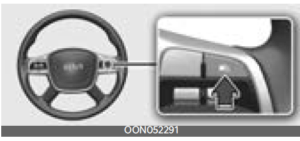
Press the Driving Assist button to turn on Smart Cruise Control. The speed will be set to the current speed on the cluster.
- If there is no vehicle in front of you, the set speed will be maintained.
- If there is a vehicle in front of you, the speed may be adjusted to maintain the distance to the vehicle ahead. If the vehicle ahead accelerates, your vehicle will travel at a steady cruising speed after accelerating to the set speed.
NOTICE
If your vehicle speed is between 0~20 mph (0~30 km/h) when you press the Driving Assist button, the set speed will be set to 20 mph (30 km/h).
Setting vehicle distance
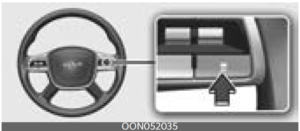
Each time the button is pressed, the headway changes as follows:
For example, if you drive at 90 km/h (56 mph), the distance is maintained as follows:
- Distance 4: approximately 172 ft. (52.5 m)
- Distance 3: approximately 130 ft. (40 m)
- Distance 2: approximately 106 ft. (32.5 m)
- Distance 1: approximately 82 ft. (25 m)
NOTICE
The distance is set to the last set distance when the vehicle is restarted, or when Smart Cruise Control was temporarily canceled.
Increasing set speed
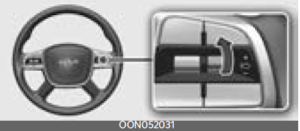
- Push the (+) switch up and release it immediately. The set speed will increase by 1 mph (1 km/h) each time the switch is operated in this manner.
- Push the (+) switch up and hold it. The set speed will increase by 5 mph (10 km/h) each time the switch is operated in this manner.
You can increase the set speed to 120 mph (200 km/h).
WARNING
Check the driving condition before using the (+) switch. Driving speed may sharply increase when you push up, hold the (+) switch and change the speed fast.
Decreasing set speed
 Push the (-) switch down and release it immediately. The set speed will decrease by 1 mph (1 km/h) each time the switch is operated in this manner.
Push the (-) switch down and release it immediately. The set speed will decrease by 1 mph (1 km/h) each time the switch is operated in this manner.- Push the (-) switch down and hold it.
The set speed will decrease by 5 mph (10 km/h) each time the switch is operated in this manner.
You can decrease the set speed to 20 mph (30 km/h).
Temporarily cancelling Smart Cruise Control
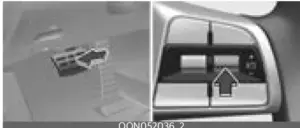 Press the ( ) switch or depress the brake pedal to temporarily cancel Smart Cruise Control.
Press the ( ) switch or depress the brake pedal to temporarily cancel Smart Cruise Control.
Resuming Smart Cruise Control
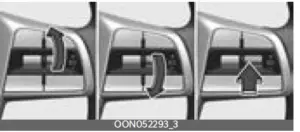
To resume Smart Cruise Control after the function was cancelled, operate the (+), (-) or ( ) switch.
If you push the (+) switch up or (-) switch down, the set speed will be set to the current speed on the cluster.
If you press the ( ) switch, the vehicle speed will resume to the preset speed.
WARNING
Check the previous set speed before using the ( ) switch. Driving speed may sharply increase or decrease when you press the ( ) switch.
Turning off Smart Cruise Control
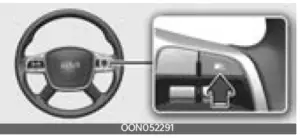
Press the Driving Assist button to turn Smart Cruise Control off.
NOTICE
If your vehicle is equipped with Manual Speed Limit Assist, press and hold the Driving Assist button to turn off Smart Cruise Control. However, Manual Speed Limit Assist will turn on.
WARNING
Do not use the switches and buttons at the same time. Smart Cruise Control may not operate properly.
Displaying operating status
You can see the status of the Smart Cruise Control operation in the Driving Assist view on the cluster.
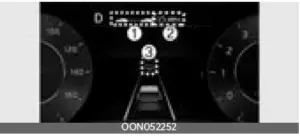
Smart Cruise Control will be displayed as below depending on the status of the function.
- When operating
- Whether there is a vehicle ahead and the selected distance level
- Set speed
- Whether there is a vehicle ahead and the target vehicle distance
- When temporarily cancelled
- Your vehicle (shaded)
- Previous set speed (shaded)
- Whether there is a vehicle ahead (shaded) (if equipped)
Accelerating temporarily
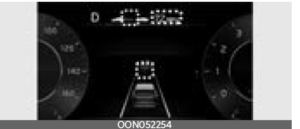
If you want to speed up temporarily without altering the set speed while Smart Cruise Control is operating, depress the accelerator pedal. While the accelerator pedal is depressed, the set speed, distance level and target distance will blink on the cluster.
However, if the accelerator pedal is depressed insufficiently, the vehicle may decelerate.
WARNING
Be careful when accelerating temporarily, because the speed and distance is not controlled automatically, even if there is a vehicle in front of you.
Based on Driving Style operating (if equipped)

A: Driving Style Adaptive SCC
When Based on Driving Style is operating, the message will appear on the cluster for 2 seconds, and the distance level and target distance will be displayed based on the driving style.
Driver assistance system
Temporarily cancelling Smart Cruise Control
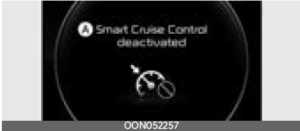
A: Smart Cruise Control deactivated
Smart Cruise Control will be temporarily cancelled automatically when:
- Your driving speed is above 130 mph (210 km/h)
- The vehicle is stopped for a certain period of time
- The accelerator pedal is continuously depressed for a certain period of time
- The conditions for the Smart Cruise
Control to operate is not satisfied
If Smart Cruise Control is temporarily cancelled automatically, the warning message will appear on the cluster, and an audible warning will sound to warn the driver.
NOTICE
If Smart Cruise Control is temporarily cancelled while the vehicle is at a stand-still with the function activated, EPB (Electronic Parking Brake) maybe applied.
WARNING
When Smart Cruise Control is temporarily cancelled, distance with the front vehicle will not be maintained. Always have your eyes on the road while driving, and if necessary, depress the brake pedal to reduce your driving speed in order to maintain a safe distance.
Smart Cruise Control conditions not satisfied

A: Smart Cruise Control conditions not met
If the Driving Assist button, (+) switch, (-) switch or ( ) switch is operated when Smart Cruise Control operating conditions are not satisfied, the warning message will appear on the cluster, and an audible warning will sound.
In traffic situation
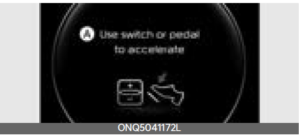
A: Use switch or pedal to accelerate
In traffic, your vehicle will stop if the vehicle ahead of you stops. Also, if the vehicle ahead of you starts moving, your vehicle will start as well.
In addition, after the vehicle has stopped and a certain time have passed, the warning message will appear on the cluster. Depress the accelerator pedal or operate the (+) switch, (-) switch or ( ) switch to start driving.
Warning road conditions ahead

A: Watch for surrounding vehicles
In the following situation, the warning message will appear on the cluster, and an audible warning will sound to warn the driver of road conditions ahead.
WARNING
Always pay attention to vehicles or objects that may suddenly appear in front of you, and if necessary, depress the brake pedal to reduce your driving speed in order to maintain a safe distance.
Collision warning
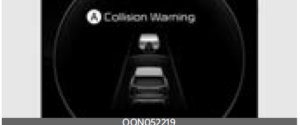
A: Collision Warning
While Smart Cruise Control is operating, when the collision risk with the vehicle ahead is high, the warning message will appear on the cluster, an audible warn-ing will sound, and steering wheel will vibrate to warn the driver. Always have your eyes on the road while driving, and if necessary, depress the brake pedal to reduce your driving speed in order to maintain a safe distance.
WARNING
In the following situations, Smart Cruise Control may not warn the driver of a collision.
Always pay attention to road and driving conditions while driving.
- The distance from the front vehicle is In the following situations, Smart Cruise Control may not warn the driver of a collision.
Always pay attention to road and driving conditions while driving. - The distance from the front vehicle is near, or the vehicle speed of the front vehicle is faster or similar to your vehicle
- The speed of the front vehicle is very slow or is at a standstill
- The accelerator pedal is depressed right after Smart Cruise Control is turned on
WARNING
- Smart Cruise Control does not substitute for proper and safe driving. It is the responsibility of the driver to always check the speed and distance to the vehicle ahead.
- Smart Cruise Control may not recognize unexpected and sudden situations or complex driving situations, so always pay attention to driving conditions and control your vehicle speed.
- Keep Smart Cruise Control off when the function is not in use to avoid inadvertently setting a speed.
- Do not open the door or leave the vehicle when Smart Cruise Control is operating, even if the vehicle is stopped.
- Always be aware of the selected speed and headway distance.
- Keep a safe distance according to road conditions and vehicle speed. If the headway distance is too close during high-speed driving, a serious collision may result.
- When maintaining distance with the vehicle ahead, if the front vehicle disappears, Smart Cruise Control may suddenly accelerate to the set speed. Always be aware of unexpected and sudden situations from occurring.
- Vehicle speed may decrease on an upward slope and increase on a downward slope.
- Always be aware of situations such as
- when a vehicle cuts in suddenly.
- When you are towing a trailer or another vehicle, turn off Smart Cruise
- Control for safety reasons.
- Turn off Smart Cruise Control when your vehicle is being towed.
- Smart Cruise Control may not operate properly if interfered by strong electromagnetic waves.
- Smart Cruise Control may not detect an obstacle in front and lead to a collision. Always look ahead cautiously to prevent unexpected and sudden situations from occurring.
- Vehicles moving in front of you with frequent lane changes may cause a delay in Smart Cruise Control’s reaction or may cause Smart Cruise Control to react to a vehicle actually in an adjacent lane. Always drive cautiously to prevent unexpected and sudden situations from occurring.
- Always be aware of the surroundings and drive safely, even though a warning message does not appear or an audible warning does not sound.
- If any other function’s warning message is displayed or a warning sound is generated, Smart Cruise Control warning message may not be displayed and a warning sound may not be generated.
- You may not hear the warning sound
of Forward Collision-Avoidance Assist if the surrounding is noisy. - The vehicle manufacturer is not responsible for any traffic violations or accidents caused by the driver.
- Always set the vehicle speed under the speed limit in your country.
- If the driver’s driving style changes, distance, acceleration and reaction speed may change.
CAUTION
- The vehicle must be driven sufficiently to reflect the actual driving style of the driver, such as vehicle distance, acceleration and reaction speed.
- Based on Driving Style may not reflect the driver’s driving style or driving conditions that affects driving safety.
- If you are driving in special conditions, such as snow, rain, fog or steep sloped roads, the vehicle may not be driven according to the driver’s driving style.
NOTICE
- Smart Cruise Control may not operate for a few seconds after the vehicle is restarted or the front view camera or front radar is initialized.
- You may hear a sound when the brakes are controlled by Smart Cruise Control.
- Based on Driving Style may not reflect the driver’s driving style that is not safe such as rapid acceleration.
- Based on Driving Style does not reflect any other driving style other than vehicle distance, acceleration and reaction speed.
Smart Cruise Control malfunction and limitations
Smart Cruise Control malfunction
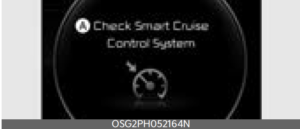
A: Check the Smart Cruise Control System
When Smart Cruise Control is not working properly, the warning message will appear, and the ( ) warning light will appear on the cluster. Have Smart Cruise Control be inspected by a professional workshop. Visit an authorized Kia dealer.
Smart Cruise Control disabled
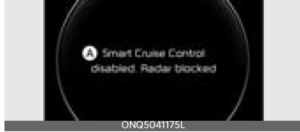
A: Smart Cruise Control disabled. Radar blocked
When the front radar cover or sensor is covered with snow, rain, or foreign material, it can reduce the detecting performance and temporarily limit or dis-able Smart Cruise Control.
If this occurs the warning message will appear for a certain period of time on the cluster.
Smart Cruise Control will operate properly when snow, rain or foreign material is removed. Always keep it clean.
WARNING
Even though the warning message does not appear on the cluster, Smart Cruise Control may not properly operate.
CAUTION
Smart Cruise Control may not properly operate in an area (e.g. open terrain), where there is nothing to detect, or detecting sensor is covered in foreign material after turning ON the vehicle.
Limitations of Smart Cruise Control
Smart Cruise Control may not operate properly, or it may operate unexpectedly under the following circumstances:
- The detecting sensor or the surroundings are contaminated or damaged
- Washer fluid is continuously sprayed, or the wiper is on
- The camera lens is contaminated due to tinted, filmed or coated windshield, damaged glass, or sticky foreign material (sticker, bug, etc.) on the glass
- Moisture is not removed or frozen on the windshield
- The field of view of the front view camera is obstructed by sun glare
- Street light or light from an oncoming vehicle is reflected on the wet road surface, such as a puddle on the road
- The temperature around the front view camera is high or low
- An object is placed on the dashboard
- The surrounding is very bright
- The surrounding is very dark, such as in a tunnel, etc.
- The brightness changes suddenly, for example when entering or exiting a tunnel
- The brightness outside is low, and the headlamps are not on or are not bright headlamps are not on or are not bright
- Driving in heavy rain or snow, or thick fog
- Driving through steam, smoke or shadow
- Only part of the vehicle is detected
- The vehicle in front has no tail lights, tail lights are located unusually, etc.
- The brightness outside is low, and the tail lamps are not on or are not bright
- The rear of the front vehicle is small or does not look normal (for example, tilted, overturned, etc.)
- The front vehicle’s ground clearance is low or high
- A vehicle suddenly cuts in front
- Your vehicle is being towed
- An object reflecting off the front radar such as a guardrail, nearby vehicle, etc.
- The bumper around the front radar is impacted, or damaged or the front radar is out of position
- The temperature around the front radar is high or low
- The vehicle in front is made of material that does not reflect on the front radar
- Driving near a highway (or motorway) interchange or tollgate
- Driving on a slippery surface due to snow, water puddle, ice, etc.
- Driving on a curved road
- The vehicle in front is detected late
- The vehicle in front is suddenly blocked by an obstacle
- The vehicle in front suddenly changes lane or suddenly reduces speed
- The vehicle in front is bent out of shape
- The front vehicle’s speed is fast or slow
- With a vehicle in front, your vehicle changes lane suddenly at low speed
- The vehicle in front is covered with snow
- Unstable driving
- You are on a roundabout and the vehicle in front is not detected
- You are continuously driving in a circle
- The adverse road conditions cause excessive vehicle vibrations while driving
- Your vehicle height is low or high due to heavy loads, abnormal tire pressure, etc.
- Driving in the following places
- Driving in a parking lot
- Driving through a construction area, unpaved road, partially paved road, uneven road, speed bumps, etc.
- Driving on an inclined road, curved road, etc.
- Driving through a roadside with trees or streetlights
- Driving through a narrow road where trees or grass are overgrown
- There is interference by electromagnetic waves, such as driving in an area with strong radio waves or electrical noise
- Driving on a curved road
- Driving through a tunnel or iron bridge
- Driving near areas containing metal substances, such as a construction zone, railroad, etc.
- Driving in vast areas where there are few vehicles or structures (for example, desert, meadow, suburb, etc.)
- Driving through steam, smoke or shadow
- Driving near a highway (or motor-way) interchange or tollgate
- Driving near areas containing metal substances, such as a construction zone, railroad, etc.
- Driving on a curved road
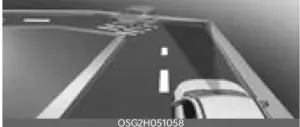
On curves, Smart Cruise Control may not detect a vehicle in the same lane, and may accelerate to the set speed. Also, vehicle speed may rapidly decrease when the vehicle ahead is detected suddenly.
Select the appropriate set speed on curves and apply the brake pedal or accelerator pedal according to the road and driving conditions ahead.

Your vehicle speed can be reduced due to a vehicle in the adjacent lane.
Check to be sure that the road conditions permit safe operation of Smart Cruise Control and if necessary, depress the brake pedal to reduce your driving speed in order to maintain a safe distance
- Driving on an inclined road
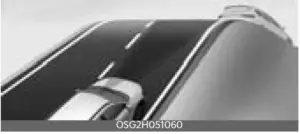
During uphill or downhill driving, the Smart Cruise Control may not detect a moving vehicle in your lane, and cause your vehicle to accelerate to the set speed. Also, vehicle speed will rap-idly decrease when the vehicle ahead is detected suddenly.
Select the appropriate set speed on inclines and apply the brake pedal or accelerator pedal according to the road and driving conditions ahead.
- Changing lanes
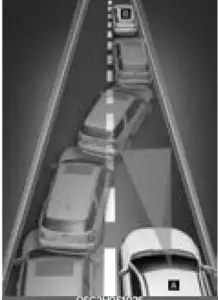
[A] : Your vehicle,
[B] : Lane changing vehicle
When a vehicle (B) moves into your lane from an adjacent lane, it cannot be detected by the sensor until it is in the sensor’s detection range. Smart Cruise Control may not immediately detect the vehicle when the vehicle changes lanes abruptly. In this case, you must maintain a safe braking distance, and if necessary, depress the brake pedal to reduce your driving speed in order to maintain a safe distance.
- Situations when detecting are limited
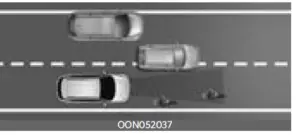
In the following cases, some vehicles in your lane cannot be detected by the sensor:
-
- Vehicles offset to one side
- Slow-moving vehicles or sudden decelerating vehicles
- Vehicles with higher ground clearance or vehicles carrying loads that stick out of the back of the vehicle
- Vehicles that have the front lifted due to heavy loads
- Vehicles within approximately 6 ft.(2 m) from your vehicle
- Oncoming vehicles
- Stopped vehicles
- Vehicles with small rear profile, such as trailers
- Narrow vehicles, such as motorcycles, bicycles, or powered two-wheelers
- Special vehicles
- Animals and pedestrians
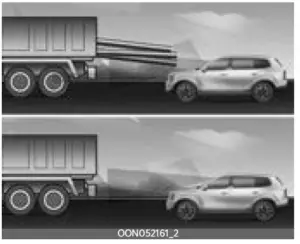
In the following cases, the vehicle in front cannot be detected by the sensor. Always pay attention to the road and driving conditions and drive safely. If necessary, adjust your vehicle speed.
-
- You are steering your vehicle
- Driving on narrow or sharply curved roads
- When a vehicle ahead disappears at an intersection, your vehicle may accelerate.
Always pay attention to road and driving conditions while driving.

- When a vehicle in front of you merges out of the lane, Smart Cruise Control may not immediately detect the new vehicle that is now in front of you.
Always pay attention to road and driving conditions while driving.

- Always look out for pedestrians when your vehicle is maintaining a distance with the vehicle ahead.
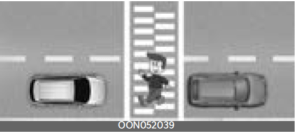
This device complies with Part 15 of the FCC rules.
Operation is subject to the following three conditions:
- This device may not cause harmful interference, and
- This device must accept any interference received, including interference that may cause undesired operation.
- Changes or modifications not expressly approved by the party responsible for compliance could void the user’s authority to operate the device.
Radiofrequency radiation exposure information:
This equipment complies with FCC radiation exposure limits set forth for an uncontrolled environment. This equipment should be installed and operated with a minimum distance of 8 in (20 cm) between the radiator (antenna) and your body.
This transmitter must not be collocated or operating in conjunction with any other antenna or transmitter.
FAQ
A: Smart Cruise Control is an advanced driver assistance feature in the 2023 Kia Telluride that automatically adjusts the vehicle’s speed to maintain a safe following distance from the vehicle ahead.
A: SCC uses radar and sensors to detect the speed and distance of the vehicle in front of you. It then adjusts your vehicle’s speed accordingly to maintain a set following distance.
A: Yes, you can typically adjust the following distance to your preference, allowing for more or less space between your vehicle and the one in front.
A: You can activate SCC by pressing the cruise control button on the steering wheel and setting your desired speed. Then, the system will automatically maintain the chosen speed and following distance.
A: If the vehicle in front of you slows down or comes to a stop, SCC will also slow down and may even bring your vehicle to a complete stop if necessary. Once the road ahead is clear, SCC will resume the set speed.
A: Yes, SCC is suitable for use in heavy traffic, as it can help reduce the need for constant acceleration and braking.
A: SCC generally works at a wide range of speeds, including highway speeds and lower-speed city driving.
A: Yes, you can typically adjust the set speed up or down while SCC is active, and the system will adapt accordingly.
A: You can deactivate SCC by either pressing the brake pedal or turning off the cruise control system using the steering wheel controls.
A: Some advanced versions of SCC can work in stop-and-go traffic, allowing the vehicle to come to a complete stop and then resume following the lead vehicle when traffic starts moving again.
A: SCC is often part of a broader suite of advanced safety features in many Kia models, which may include features like lane-keeping assist and blind-spot monitoring.
A: Smart Cruise Control is often synonymous with adaptive cruise control and operates in a similar manner, automatically adjusting the vehicle’s speed to maintain a safe following distance.
A: Some vehicles allow you to adjust the sensitivity or responsiveness of SCC to your liking within certain parameters.
A: While SCC generally works well in various weather conditions, factors like heavy rain, fog, or snow can affect its performance, as it relies on clear sensor readings.
A: Yes, Smart Cruise Control is typically designed to be user-friendly and can be easily activated and adjusted through the vehicle’s settings and controls.
To turn off Smart Cruise Control in a Kia Telluride, press the “Cancel” button on the steering wheel.
Useful Link
View Full User Guide: Kia Telluride 2023 User Guide
Download Manuals: https://owners.kia.com/content/owners/en/manuals.html
2023 Kia Telluride Specs, Price, Features and Mileage (Brochure)

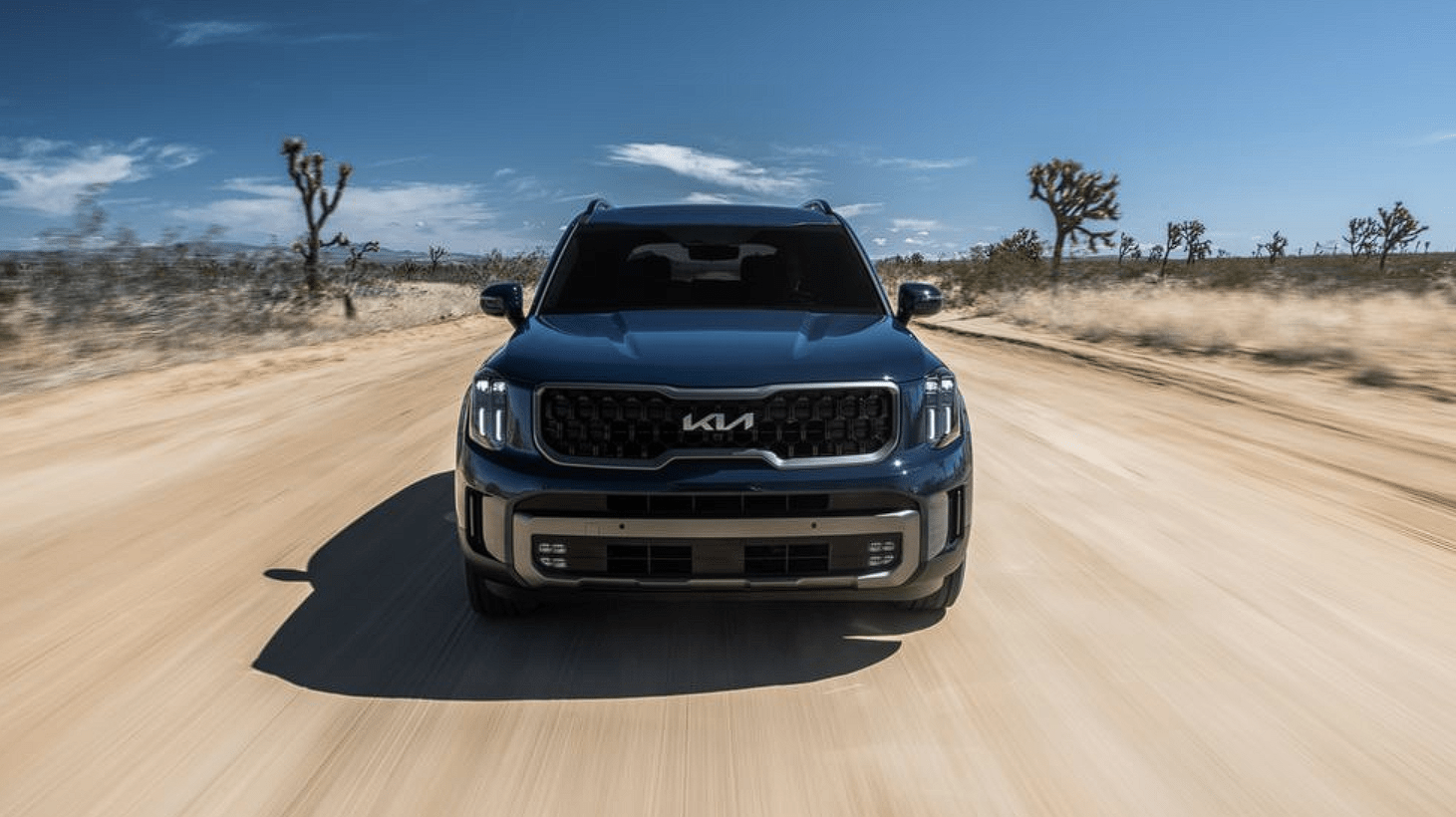

6 replies on “2023 Kia Telluride Smart Cruise Control Guidelines”
Can you switch from smart cruise to conventional cruise? If road conditions are good, this should be an option. I have twice, had smart cruise say radar is blocked and system shuts off. Completely unwarranted because road conditions allowed traffic to travel at normal speeds.
Yes, it is generally possible to switch from smart cruise control to conventional cruise control in a Kia Telluride or any other vehicle that offers both types of cruise control. The process for switching modes may vary depending on the specific model and year of the vehicle, but it is typically done through the vehicle’s infotainment system or by using a button on the steering wheel or dashboard.
If you are experiencing issues with your Kia Telluride’s smart cruise control system, such as the radar being blocked and the system shutting off when road conditions are good, it may be worth having the system checked by a certified Kia technician. There could be a problem with the radar sensor or other components of the system that is causing it to malfunction.
Please detail exactly how to switch from smart cruise to standard cruise for 2023 Telluride. I have a SXP.
I find this was detailed in the 2022 manual, but that procedure does not work for 2023 models.
Thanks
To switch from Smart Cruise Control to standard cruise control in your 2023 Kia Telluride, follow these steps:
Locate the cruise control lever on the right side of the steering wheel.
Push the lever upward to activate the cruise control system.
Once the cruise control is activated, you will see a cruise control icon displayed in the instrument cluster.
To switch from Smart Cruise Control to standard cruise control, press the “CRUISE” button on the end of the cruise control lever.
The Smart Cruise Control icon in the instrument cluster will be replaced by a standard cruise control icon, indicating that the system has switched over.
Adjust your speed using the “+” and “-” buttons on the cruise control lever as desired.
To cancel the cruise control system, push the lever downward or press the brake pedal.
It’s worth noting that the Smart Cruise Control system in the 2023 Kia Telluride is designed to automatically maintain a set distance from the vehicle in front of you, while standard cruise control only maintains a set speed. Therefore, if you switch to standard cruise control, you will need to manually adjust your distance from other vehicles as you drive.
Well that is not correct because the 2023 Telluride does not have a cruise control lever. There are 4 controls on the right side steering wheel. Smart cruise , lane following and distance spacing. The 4th is a paging button for driver info center.
Perhaps you are referring to foreign or previous model, certainly not 2023 . Again, how do I change from smart cruise control to standard cruise.
Press the “CRUISE” button located on the steering wheel to activate the cruise control system.
Using the “MODE” button on the steering wheel, cycle through the different cruise control modes until you reach “CC” (which stands for “Conventional Cruise”).
Once “CC” is displayed on the instrument cluster, adjust your desired cruising speed using the “SET” button on the steering wheel.
The vehicle will now maintain the set speed until the cruise control is turned off or the brake pedal is pressed.
Note: The specific location of the buttons may vary depending on the trim level and options of your Telluride, but the general process should be similar. If you have trouble finding the buttons or activating the cruise control system, consult your local Kia dealership for assistance.